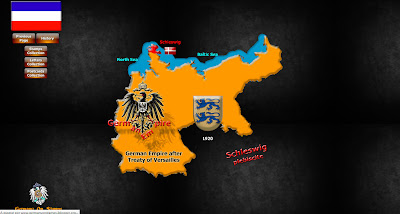
SCHLESWIG


North and South Schleswig (in this map in red and orange, respectively)
Schleswig or Southern Jutland – in Danish "Sønderjylland" or "Slesvig", in German "Schleswig", in Low German "Sleswig" – is a region covering the area about 60 km north and 70 km south of the border between Germany and Denmark.
The Duchy of Schleswig, or Southern Jutland, was originally an integral part of Denmark, but was, in medieval times established as a fief under the Kingdom of Denmark, with the same relation to the Danish Crown as for example Brandenburg or Bavaria vis-à-vis the Holy Roman Emperor.
Feuds and marital alliances brought the Abel dynasty into a close connection with the German Duchy of Holstein by the 15th century. The latter was a fief subordinate to the Holy Roman Empire, while Schleswig remained a Danish fief. These dual loyalties were to become a main root of the dispute between the German states and Denmark in the 19thcentury, when the ideas of romantic nationalism and the nation-state won popular support.
Before World War I
Conflict between Denmark and German states over Schleswig and Holstein led to the Schleswig-Holstein Question of the 19thcentury. Denmark attempted to integrate the Duchy of Schleswig into the Danish kingdom in 1848, leading to an uprising of ethnic Germans who supported Schleswig's ties with Holstein. The military intervention of the Kingdom of Prussia supported the uprising: the Prussian army drove Denmark's troops from Schleswig and Holstein in the First Schleswig War of 1848–1851.
Denmark again attempted to integrate Schleswig in 1864, but the German Confederation defeated the Danes in the Second War of Schleswig. Prussia and Austria respectively assumed administration of Schleswig and Holstein under the Gastein Convention of 14 August 1865. However, tensions between the two powers culminated in the Austro-Prussian War of 1866. In the Peace of Prague, the victorious Prussians annexed Schleswig and Holstein, creating the province of Schleswig-Holstein.
Provision for the cession of northern Schleswig to Denmark was made pending a popular vote in favour of this. In 1878, however, Austria went back on this provision. Denmark with Germany, in a Treaty of 1907, recognized, by the agreement between Austria and Prussia, the frontier between Prussia and Denmark.
Schleswig Plebiscite after World War I
The Allied powers arranged a referendum in Northern and Central Schleswig. In Northern Schleswig on February 10, 1920 75% voted for re-unification with Denmark and 25% voted for Germany. In Central Schleswig on March 14, 1920 the results were reversed; 80% voted for Germany and just 20% for Denmark, primarily in Flensburg. While in Northern Schleswig some smaller regions had a clear majority of voters for Germany in Central Schleswig all regions voted for Germany.
No vote ever took place in the southern third of Schleswig, because the result for Germany was predictable.
On June 15, 1920, Northern Schleswig officially returned to Danish rule. Germany continued to hold the whole of Holstein and southern and central Schleswig, later becoming the Prussian province of Schleswig-Holstein. The Danish-German border was the only one of the borders imposed on Germany following World War I which was never challenged by Hitler.
World War II
In the Second World War, after Nazi Germany occupied the whole of Denmark, there was agitation by local Nazi leaders in Schleswig-Holstein to restore the pre-World War I border and re-annex to Germany the areas granted to Denmark after the plebiscite — as the Nazis did in Alsace-Lorraine at the same period. However, Hitler vetoed any such step, out of a general Nazi policy at the time to base the occupation of Denmark on a kind of accommodation with the Danish Government, and avoid outright confrontations with the Danes.
After World War II
After Germany had lost World War II there again was a possibility that Denmark could reacquire some of its lost territory in Schleswig. Though no territorial changes came of it, it had the effect that Prime Minister Knud Kristensen was forced to resign after a vote of no confidence because the Folketing (Parliament of Denmark) did not support his enthusiasm for incorporating Southern Schleswig into Denmark.
Although there was, as a result, a Danish minority in Southern Schleswig and a German minority in Northern Schleswig, the minorities were granted rights to practice their language and culture, to such a degree that the division and minorities as of 2009 are not a political issue between Denmark and Germany.


































































